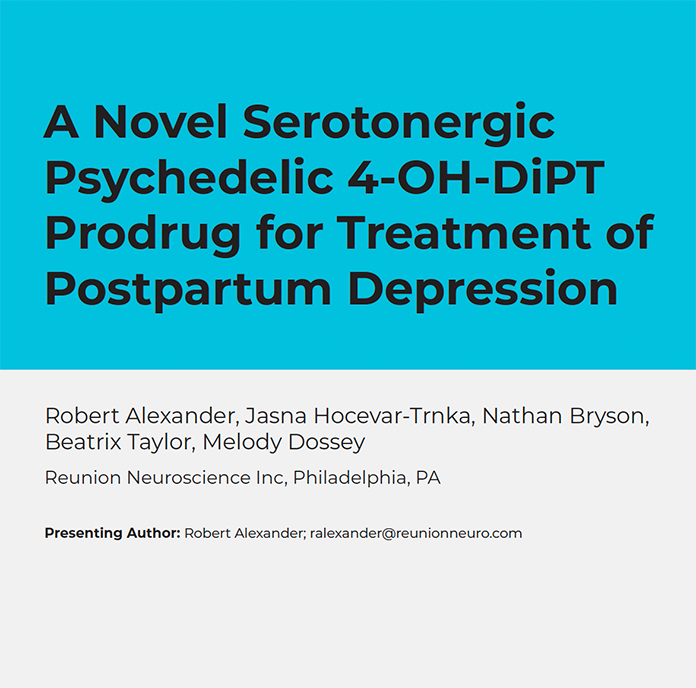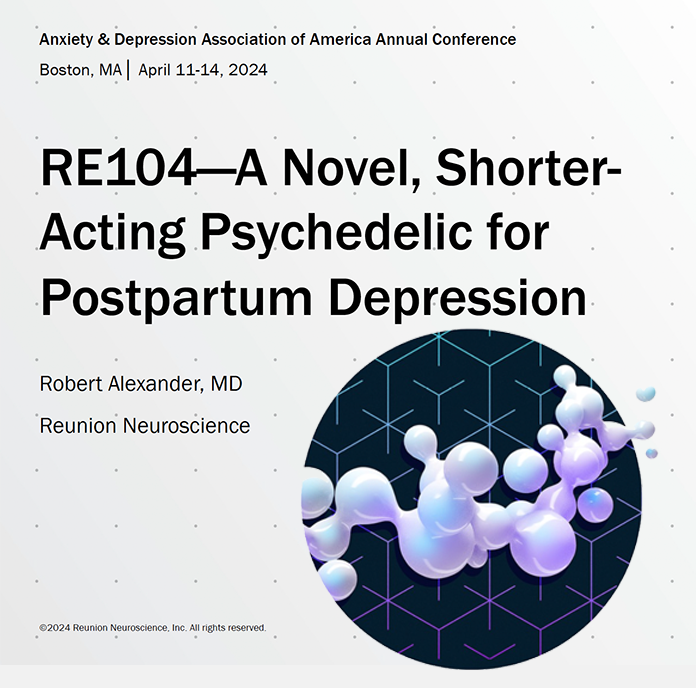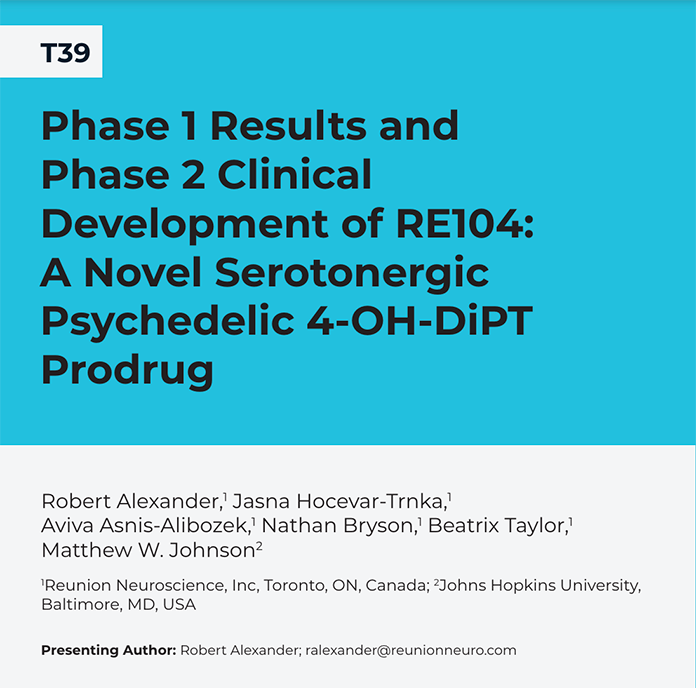
Science
Developing New Frontiers of Innovation for Transformational Progress

Serotonergic Psychedelic Mechanism
Our approach to developing novel therapeutics is inspired by decades of psychedelic research demonstrating promising results for a variety of mental health conditions. Current treatments such as serotonin reuptake inhibitors (SSRIs) are associated with limited efficacy and harmful side effects, and require continuous dosing. Classic psychedelics have been shown to produce unprecedented durable efficacy in a single dose. Specifically, RCT studies demonstrate the benefits of psilocybin in depression after one dose. Our focus is to advance the initial discoveries of 5HT2A compounds and develop new agents with safe, effective profiles.
We are advancing our lead candidate, RE104, a potential best-in-class, short duration, patented prodrug of 4-OH-DiPT, a psilocybin-like compound. RE104 targets the serotonin 2A receptor (5HT2AR), which is the recognized target for the antidepressant effects of psychedelic compounds.
With our exclusive rights to RE104, we can evaluate RE104 in various underserved mental health disorders and are actively investigating its use in additional indications susceptible to being treated with a 5HT2A agonist molecule.
INDICATIONS
Postpartum Depression
We are evaluating RE104 evaluated in the RECONNECT Phase 2 clinical trial as a potential treatment for women suffering from postpartum depression (PPD), which is a major form of depression that is estimated to affect about 10-15% of all mothers of newborns. Women suffering from PPD often experience significant changes in mood, appetite and sleep contributing to feelings of hopelessness, lack of concentration, loss of energy, poor self-esteem and maternal disinterest.
The only viable regulatory approved therapy indicated for PPD has side effects that include sedation (with Black Box warning) and potential addiction and embryo-fetal toxicity. SSRIs, which are often prescribed off-label, take a long time for onset and only show limited efficacy, representing a concern for the safety, well-being and long-term development of the child.
While there have been recent developments in treatment options for PPD, there continues to be a significant unmet need for a solution that offers a faster onset of action, greater efficacy after only a single dose, with limited interruption in breast feeding and a faster return to normal daily activities.
Adjustment Disorder in Cancer
We are also planning to evaluate RE104 as a potential therapy solution for adjustment disorder in cancer (ADC). It is estimated that 23.4% of cancer patients suffer from depression and 19.1-19.9% suffer from anxiety. ADC is one of the initial indications studied by researchers on psychedelic treatment and several clinical trials indicate the potential for rapid and meaningful improvements in depression and anxiety with durable changes in attitude and behavior.
Cancer patients under psychological distress have reduced compliance with treatment and prolonged hospitalizations. Psychosocial distress interferes with the ability to cope effectively with cancer, its physical symptoms and treatment. This in turn can contribute to poor outcomes in patients.
We believe there is a significant unmet need for a rapid acting solution for these cancer patients to positively impact cancer treatment compliance, hospitalization time and improved quality of life.
PIPELINE
Promising New Science: Serotonergic Psychedelics
Direct agonism of the serotonin-2A (5HT-2A) receptor via serotonergic psychedelic therapy has shown immediate and durable clinical outcomes after a single dosage. We’re working to advance the initial discoveries of 5HT-2A compounds and develop new agents with safe, effective profiles.

RE104
RE104 is a patented, clinical-stage drug candidate designed as a safe, fast-acting, short duration serotonergic psychedelic therapeutic to provide lasting benefits to patients with underserved mental health disorders. RE104 aims to provide a safe and effective new therapeutic option for the large population of underserved patients suffering from postpartum depression and potentially other psychiatric indications of high unmet need.
RE104 rapidly converts to the clinically-active serotonergic form of the drug, 4-OH-DIPT (4-hydroxy-N,N-diisopropyltryptamine) after administration. Our Phase 1 clinical data indicate that RE104 produces a pharmacology similar to psilocybin with a reduced duration of the psychoactive experience.
In a Phase 1 clinical trial, RE104 was shown to be generally safe and well-tolerated and was rapidly cleared from systemic circulation. Additionally, RE104 showed robust and pervasive pharmacodynamic effects with a duration of approximately three to four hours (versus six to eight hours for psilocybin).
RE104 is being evaluated in the RECONNECT Phase 2 clinical trial, a Phase 2, Multicenter, Randomized, Double-Blind, Parallel-Group, Active Dose-Controlled study evaluating RE104 in moderate and severe PPD patients.
We are actively investigating the use of RE104 in additional indications susceptible to being treated with a 5HT2A agonist molecule.
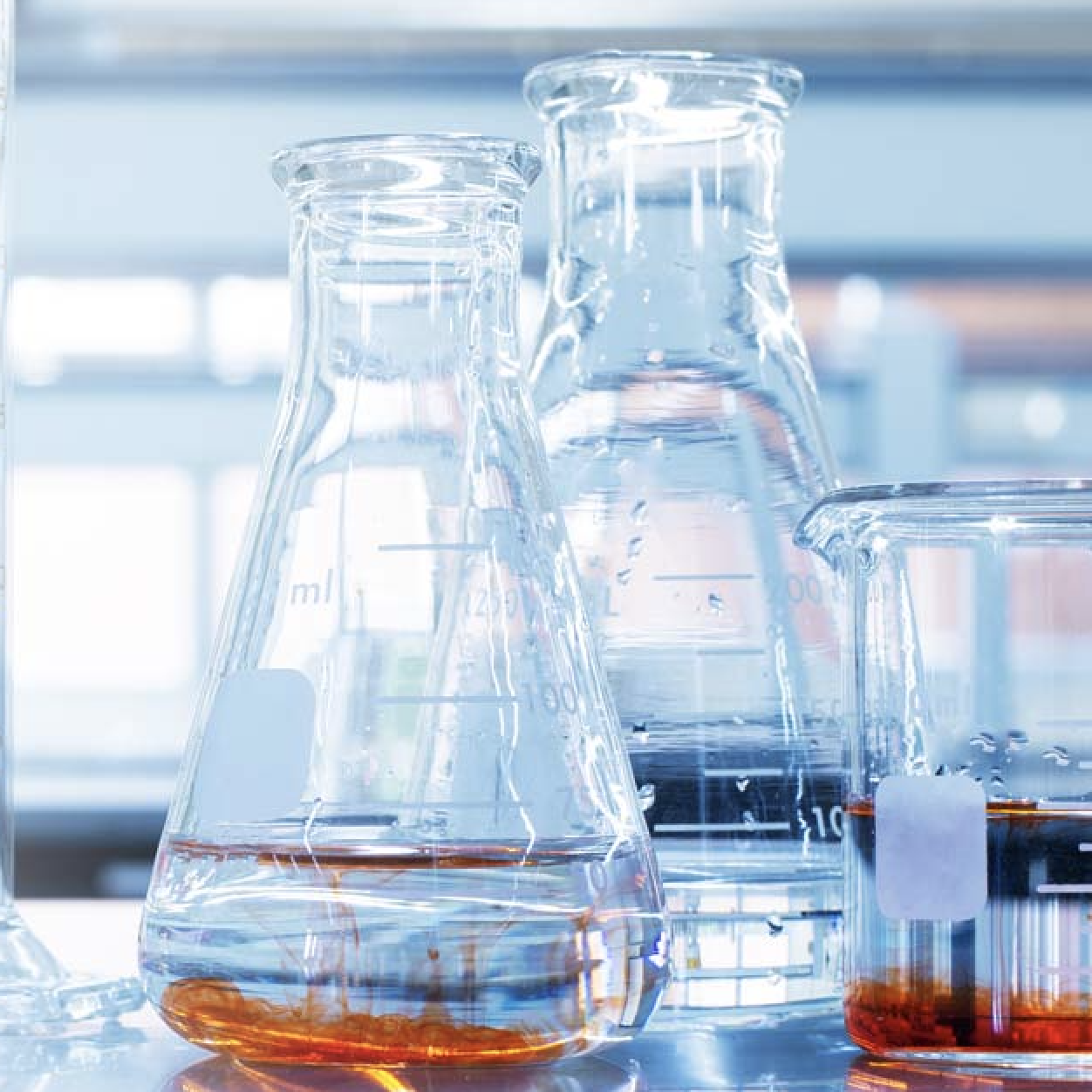
RE200s
Our RE200 series of drug discovery candidates are structurally similar to classical psychedelics. They are designed to have selective potency at the target serotonin 2A receptor (5HT2A) and are devoid of off-target 5HT2B receptor agonism.
PUBLICATIONS
A Novel Serotonergic Psychedelic 4-OH-DiPT Prodrug for Treatment of Postpartum Depression Read more
Dr. Robert Alexander 2024 ADAA Podium Presentation Slide Deck: RE104 – A Novel, Shorter-Acting Psychedelic for Postpartum Depression Read more
Phase 1 Results and Phase 2 Clinical Development of RE104: A Novel Serotonergic Psychedelic 4-OH-DiPT Prodrug Read more
BACKGROUND PUBLICATIONS
Barrett FS, Johnson MQ, Griffiths RR. Validation of the revised Mystical Experience Questionnaire in experimental sessions with psilocybin. J Psychopharmacol. 2015;29(11):1182-1190. Read more
Haijen E, Kaelen M, Roseman L, et al. Predicting responses to psychedelics: A prospective study. Front Pharmacol. 2018;9:897. Read more
Hirschfeld T and Schmidt TT. Dose-response relationships of psilocybin-induced subjective experiences in humans. J Psychopharmacol. 2021;35(4):384-397. Read more
Klein AK, Chatha M, Laskowski J, et al. Investigation of the structure-activity relationships of psilocybin analogues. ACS Pharmacol Transl Sci. 2021;4(2):533-542. Read more
Waters K. Pharmacologic similarities and differences among hallucinogens. J Clin Pharamcol. 2021;61(S2):S100-S113. Read more
Yaden DB and Griffiths RR. The subjective effects of psychedelics are necessary for their enduring therapeutic effects. ACS Pharmacol Transl Sci. 2021;4(2):568-572. Read more
